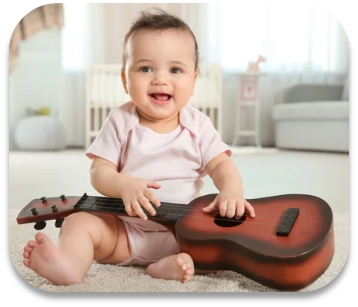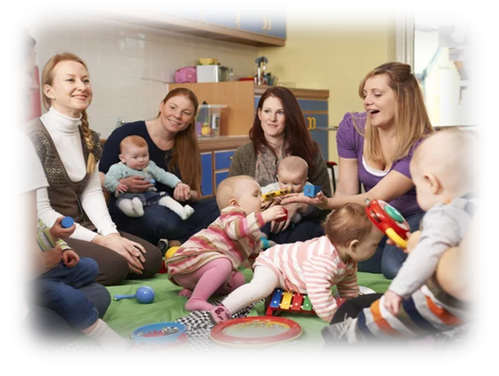INTERACTIVE
Movers & Shakers
3 months to 12 months

December 22, 2023
An older baby’s interactive musical connections are expressed in many different ways. Their large motor skill development now allows their body to “get their groove on”! Active participation is easier. The baby’s arms can grasp objects and hold them longer. Their legs are physically stronger for kicking, crawling and sitting up. Music Time now encompasses a baby style of making music and moving to music. It may be presented as a solo performance while the music is playing or a “jam session” of merrily making sounds and noises.

In the beginning holding the baby close while moving to music starts the baby dance. It’s a partnership shaped by the musical sounds heard together. ”For babies, the musical component of interactive movement and dance routines provides them with stimulating rhythm and enveloping personal touch that may have a profound effect on their development.” stated Michael Hogan Ph.D. in an article titled, Dancing With Your Baby. Rocking back and forth or swaying side to side while listening to the beat of the song together is a valuable experience.
When the baby is older, a parent may hold their baby in a couples’ slow dance-position. Support the weight of the baby’s body with one arm and clasp their hand or hands. This allows for livelier movements. Presto — as dance partners there’s twirling and giggling to be done!
Once a baby’s large muscles allow them to stand while holding onto something and there’s music playing--watch for the famous “booty bounce” to appear. Spoiler alert--it won’t be too long before their first solo dance may follow!
A baby will communicate their own level of “want” for the length of Music Time—and will send out a clear message that shares whether to continue or not. Always honor their desire, for there are more dance parties to be had by all.
A baby is not ready to play a masterpiece on a grand piano q uite yet, that’s for sure!. Instead, they will bring on the banging and clanging whether one is ready for it or not--- “for the beat must go on and on”. Here’s how and what one may use to help with those musical experiences at this early active stage.
1.
Examples of Sound Makers ---found in the home or home-made
- Objects used to produce sounds—for drumming, banging, clanging etc.
- Pots/pans
- Large plastic or wooden spoons
- Plastic containers with lids
- Cereal Boxes or containers
- Tin Cans with plastic LIDS
- Tin Buckets
- Objects used to produce sounds—for shaking
- small plastic water bottles with LIDS (filled with rice, beans, pasta etc.)
- small plastic containers with LIDS (filled with items)

SAFETY is the number one consideration. Remember they are still in the “taste test period”
and everything goes right into their mouth.
Soft edges only – cover all sharp edges with tape-(duct tape may work) for protection.
LIDS must be secure – tape or glue them closed, –if GLUE—be sure it’s safe for babies!
Wooden spoons must be in good shape – or splinters could get into their mouth.
Whole objects may be covered with sticky contact paper and lots of tape. This hides what
is inside and makes it colorful on the outside. (plastic bottles, small tin cans etc.)
Check the sound producers regularly – in case they are in need of repair or replacing.
2.
Examples of Toy Musical Instruments OR Toys that make sounds
Toy sound makers may already be in your home. (baby rattles, other toys that squeak– stuffed/rubber animals etc.) There are many ways to find toy musical instruments which are not brand new. Visit a local thrift store or stop by a garage sale -- lots of bargains galore to find. After purchasing the items, wash them thoroughly before giving to baby.

3.
Examples of Real Musical Instruments
- Real musical instruments can be part of their sound discovery
- experiences - bells, maracas, bongos etc. Large instruments may
- need a parents’ guidance and watchful eye. If this is a family.
- and might get damaged--wait until the baby is older and more capable
- of following directions. OR sit with them and provide guidance on how
- to play the keys or strum the strings or hit the drums. Joining together
- is an excellent way to bond while playing any musical instrument.
- Real musical instruments can be part of their sound discovery experiences - bells, maracas, bongos etc. Large instruments may need a parents’ guidance and watchful eye. If this is a family. and might get damaged--wait until the baby is older and more capable of following directions. OR sit with them and provide guidance on how to play the keys or strum the strings or hit the drums. Joining together to play the keys or strum the strings or hit the drums. Joining together is an excellent way to bond while playing any musical instrument.

Once a collection of musical objects has been gathered, it’s time to make a music box. Place the items into a container for safe keeping, ready and waiting for Music Time. One may decide to place the music box on the bottom shelf of a kitchen cupboard or another different storage location. Start with about six or so items to go inside their music box. Later-on, switch out a few for different ones and watch how they try to figure out how each newly introduced sound producer works. Home-made items, toy and real musical instruments all are beneficial tools for expanding a baby’s musical connections. Their baby brain is bustling away inside with musicality, learning is taking place.
Select some lively music for the baby to hear as they shake and drum away. The baby will happily entertain themselves as well as anyone else who is around. What interesting sounds will now fill the air!

How about a little adventure? O.K. Let’s take Music Time on the road and share the talent.Going out of the house to join a music club or class combines singing, dancing and music making with social interactions. Engaging with other parents and their babies is a unique opportunity!
Casual Gathering: Get together with some friends and their babies at someone’s home. Bring along some of those musical items from their music box or ones currently not in use. Parents sit comfortably on the floor in a circle with the baby in or near their lap. Sound makers are placed in the center of circle for individual selection or have been handed out earlier to the babies. Younger babies may need assistance with shaking or drumming a musical object. Learning how an item works or how to keep a beat is all part of their musical experience. Select engaging music to play or sing lively songs during this time.
Paid Sessions: Parents will need to find a business that provides music classes. These companies do charge a fee for their services. A teacher will guide the group of parents and babies in their musical development. There will be plenty of time for listening and movement activities. The internet offers various resources for baby classes, some are designed to be used in a zoom format.
One needs to consider a group activity may not always bring happiness. Babies are still in the me stage and sharing is not in their bag of tricks. Just because a parent signs up both participants, doesn’t mean it will be an immediate success. It will depend on the mood of the baby, the actual overall session and so many other variables. This should be a fun activity for both the parent and the baby. Continual frustrations and upsets by the adults or other babies during a session will impact the entire experience. However, a positive musical jamboree brings multiple benefits for all.
If being part of an outside musical group isn’t the right fit — have no worries— family Music Time is a grand way to involve the baby with a musical group!
Put some music on, grab some musical items and your baby, it’s a family musical shindig.
Or let loose and dance together to some favorite tunes. Party on and let the music flow!
”During the first year of life, rhythm is the element of music that has the greatest effect.”
Resources & References
ABC Magazine, Benefits of musical toys for babies and how to make your own, McKinsey, Ellie,
https://abcmag.co.uk/benefits-of-musical-toys-for-babies-and-how-to-make-your-own//John Hopkins Medical Health, The Growing Child: 10-12 Months,
https://www.hopkinsmedicine.org/health/wellness-and-prevention/the-growing-child-10-to-12-monthsPsychology Today, (2014), Dancing With Your Baby, Hogan, Michael, Ph. D.,
https://www.psychologytoday.com/us/blog/in-one-lifespan/201409/dancing-your-babyUniversity of Washington Institute For Learning & Brain Sciences, (2016), Music Improves Baby Brain Responses to Music and Speech, I-LABS, https://ilabs.uw.edu/i-labs-news/music-improves-baby-brain-responses-music-and-speech/
Early Literacy Learning


